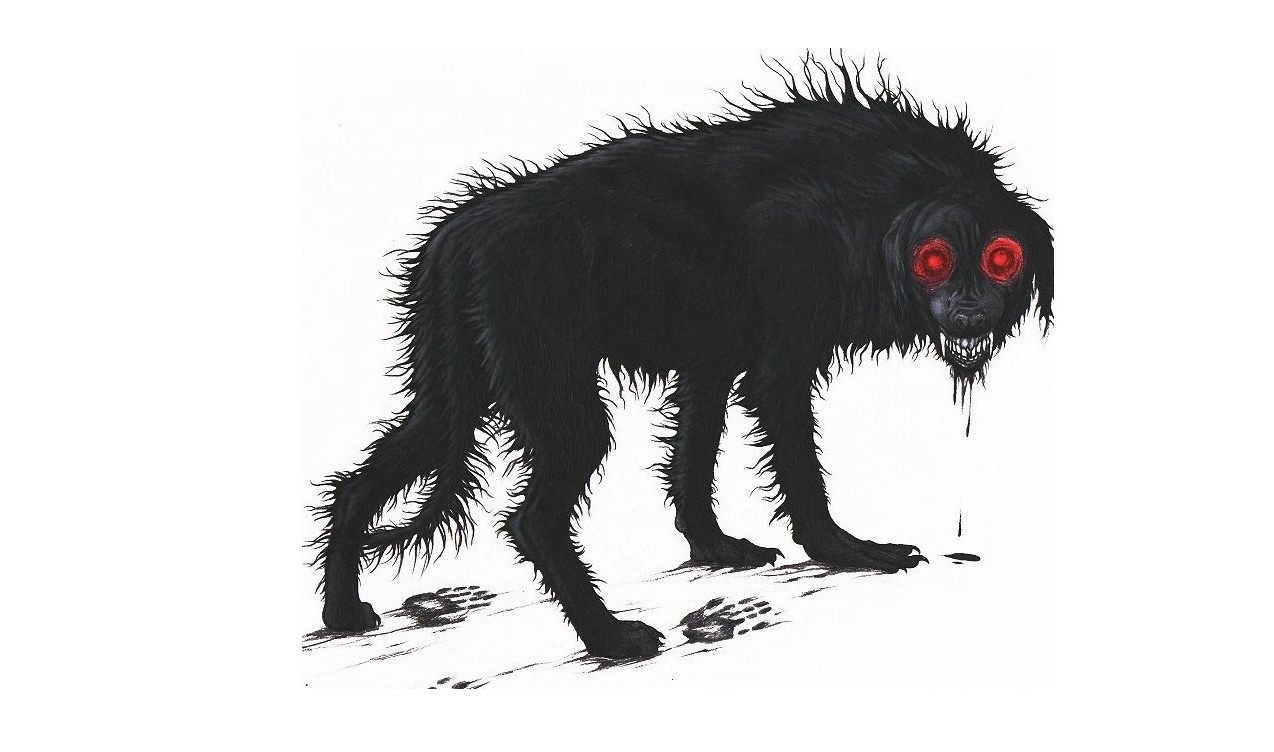
Have you ever heard of Black Shuck, the legendary devil dog of English folklore? This eerie creature has haunted the imaginations of East Anglia's residents for centuries. Described as a massive black dog with glowing red eyes, Black Shuck is often seen as an omen of death and misfortune. Its name, derived from the Old English word "scucca," meaning demon, hints at its sinister nature. From stormy nights to secluded crossroads, tales of this spectral hound have been passed down through generations. Whether you're a folklore enthusiast or just curious, the story of Black Shuck is sure to send shivers down your spine.
Key Takeaways:
- Black Shuck, a legendary creature from English folklore, is a supernatural hound with a sinister reputation, known for sudden appearances and eerie behavior, adding to its terrifying legacy.
- Black Shuck's enduring presence in English folklore reflects primal fears of death and the unknown, shaping literature, art, and popular culture, making it an integral part of cultural heritage.
The Origins of Black Shuck
Black Shuck, a legendary creature from English folklore, has haunted the imaginations of many for centuries. This mythical hound is deeply rooted in the cultural heritage of East Anglia and beyond. Let's dive into the fascinating world of Black Shuck.
-
Origin of the Name: The name "Black Shuck" comes from the Old English word "scucca," meaning "demon" or "devil." This etymology highlights its sinister reputation.
-
First Written Record: The earliest known text describing Black Shuck dates back to 1127 in Peterborough, England. This ancient record marks the beginning of its terrifying legacy.
Physical Appearance and Behavior
Descriptions of Black Shuck vary, but certain features remain consistent. Its appearance and behavior add to its eerie mystique.
-
Physical Description: Typically described as a large dog with black, mangy fur, Black Shuck's size ranges from that of a large dog to as big as a horse.
-
Appearance: Often depicted with glowing red eyes and a rough, coarse coat, its eyes are said to be big and round, like saucers.
-
Behavior: Known for sudden, unexplained appearances, Black Shuck vanishes as quickly as it arrives, leaving witnesses in shock.
Habitat and Supernatural Nature
Black Shuck is often found in places associated with death and the spirit world. Its supernatural nature makes it more than just a regular beast.
-
Habitat: This creature roams fens, marshes, bogs, dark forests, empty fields, gallows, cemeteries, unmarked graves, side roads, and secluded footpaths and crossroads.
-
Supernatural Nature: Despite its physical form, Black Shuck is heavily implied to be a supernatural entity, often seen as an omen of death.
Historical Sightings and Incidents
Historical accounts of Black Shuck add to its terrifying legend. These stories have been passed down through generations, each adding to its fearsome reputation.
-
Historical Sightings: One notable report by Abraham Fleming in 1577 describes Black Shuck breaking into a church during a storm, killing two parishioners.
-
Church Incident: In Fleming's account, Black Shuck ran among the congregation, breaking the necks of two people kneeling in prayer. Another man was bitten but survived.
Associations with Weather and Locations
Black Shuck's appearances are often linked to specific weather conditions and locations, adding to its eerie presence.
-
Storms and Weather: Black Shuck enjoys storms and the roaring of waves, often raising its voice above the howling gale.
-
Crossroads and Roads: Crossroads and roads, considered "between the worlds," are common places for Black Shuck sightings, adding to their eerie nature.
Death Omens and Variations in Appearance
Meeting Black Shuck is often seen as a bad omen. Its appearance and significance vary across different regions and stories.
-
Death Omens: Encountering Black Shuck is believed to be a warning of impending death within the year.
-
Variations in Appearance: Despite consistent descriptions, there are significant variations in its physical features and significance across different regions.
Black Dogs in Folklore
Black Shuck is part of a broader tradition of black dog legends in European folklore. These creatures share similarities but also have unique traits.
-
Black Dogs in Folklore: Known by various names like Barghest, Hairy Jack, Padfoot, and more, black dogs are a common theme in European folklore.
-
Regional Variations: While Black Shuck is most prominent in East Anglia, similar creatures exist in other parts of England and Europe, each with unique traits.
Archaeological Finds and Modern Sightings
Modern discoveries and sightings continue to fuel the legend of Black Shuck, blending historical facts with contemporary storytelling.
-
Archaeological Dig: In 2013, an archaeological dig at Leiston Abbey in Suffolk uncovered skeletal remains of a very large dog, initially thought to be Black Shuck.
-
Folkloric Inaccuracies: The story of the 7-foot hound from hell was later debunked, showing how folklore can be distorted through modern media.
-
Modern Sightings: Despite the lack of concrete evidence, modern sightings of large black dogs continue to fascinate people.
Psychological and Cultural Impact
The fear of Black Shuck is deeply rooted in psychological and cultural aspects, reflecting the darker sides of human nature and the supernatural.
-
Psychological Impact: Black Shuck's appearance and behavior tap into primal fears of death and the unknown.
-
Cultural Significance: Serving as a cultural icon, Black Shuck reflects the darker aspects of human nature and the supernatural.
Historical Context and Symbolism
Understanding the historical context and symbolism of Black Shuck helps explain its enduring presence in folklore.
-
Historical Context: The legend emerged during a time when superstition and fear of the unknown were prevalent.
-
Symbolism: Black Shuck symbolizes death, the Devil, or even a protective spirit, reflecting the complexities of human beliefs about the supernatural.
Influence on Literature and Popular Culture
Black Shuck's legend has influenced various works of literature and popular culture, keeping its story alive through the ages.
-
Literary Influence: The legend has inspired works like Arthur Conan Doyle's The Hound of the Baskervilles.
-
Cultural Legacy: Black Shuck's legacy extends beyond its historical context, influencing literature, art, and popular culture.
Educational and Folkloric Value
Studying Black Shuck offers valuable insights into cultural anthropology and the evolution of human beliefs, highlighting the importance of folklore.
-
Educational Value: Black Shuck provides insights into cultural anthropology and the evolution of human beliefs.
-
Folkloric Transmission: The transmission of Black Shuck's legend demonstrates how stories are retold and disseminated through generations.
Psychological Impact on Children
Stories about Black Shuck can have a profound psychological impact on children, shaping their perceptions of the supernatural.
- Psychological Impact on Children: These stories can shape children's perceptions of the supernatural and their fears.
Historical Accuracy and Cultural Preservation
While the historical accuracy of Black Shuck sightings is questionable, the stories themselves are undeniably fascinating and contribute to cultural preservation.
-
Historical Accuracy: The accuracy of sightings is questionable, but the stories offer a glimpse into the collective psyche of past generations.
-
Cultural Preservation: The legend helps preserve cultural heritage, reminding us of the rich folklore that has shaped English history.
Modern Interpretations and Archaeological Misinterpretations
Modern interpretations and archaeological findings continue to shape the legend of Black Shuck, blending fact and fiction.
-
Modern Interpretations: Blending historical facts with contemporary storytelling helps keep the legend relevant.
-
Archaeological Misinterpretation: The 2013 dig at Leiston Abbey was initially misinterpreted as evidence of Black Shuck, showing how findings can be misused to support folklore claims.
Consistency and Psychological Fears
Despite inaccuracies in modern retellings, the core elements of Black Shuck's legend remain consistent, tapping into deep-seated psychological fears.
-
Folkloric Accuracy: Core elements of the legend remain consistent, underscoring the enduring nature of folklore.
-
Psychological Fears: The fear of Black Shuck taps into deep-seated fears related to death, the unknown, and supernatural entities.
Cultural Legacy and Influence
Black Shuck's legacy continues to influence literature, art, and popular culture, making it an integral part of English folklore.
-
Cultural Legacy: Black Shuck's influence extends beyond its historical context, shaping literature, art, and popular culture.
-
Enduring Presence: Whether seen as a death omen or a protective spirit, Black Shuck remains an integral part of England's cultural heritage.
The Enduring Legend of Black Shuck
Black Shuck, the legendary devil dog of English folklore, has captivated imaginations for centuries. With its origins dating back to the 12th century, this supernatural hound is deeply rooted in the cultural heritage of East Anglia. Known for its terrifying appearance and association with death, Black Shuck has been a symbol of fear and fascination. From historical sightings to modern interpretations, the legend continues to thrive, reflecting the complexities of human beliefs about the supernatural. Whether seen as a death omen or a protective spirit, Black Shuck remains an integral part of England's folklore. Its enduring presence in literature, art, and popular culture highlights the power of storytelling in shaping societal perceptions. As we explore the mysteries of Black Shuck, we gain valuable insights into the collective psyche of past generations and the timeless allure of the unknown.
Frequently Asked Questions
Was this page helpful?
Our commitment to delivering trustworthy and engaging content is at the heart of what we do. Each fact on our site is contributed by real users like you, bringing a wealth of diverse insights and information. To ensure the highest standards of accuracy and reliability, our dedicated editors meticulously review each submission. This process guarantees that the facts we share are not only fascinating but also credible. Trust in our commitment to quality and authenticity as you explore and learn with us.


